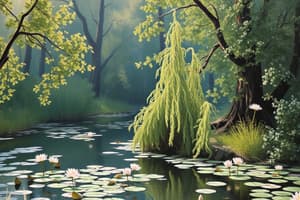Podcast
Questions and Answers
Quels facteurs influencent directement les êtres vivants selon le contenu?
Quels facteurs influencent directement les êtres vivants selon le contenu?
- Granulométrie du sol
- Lumière et énergie lumineuse (correct)
- Recherche d’un partenaire sexuel (correct)
- Pression atmosphérique
Quel facteur climatique n'est pas mentionné comme impactant les êtres vivants?
Quel facteur climatique n'est pas mentionné comme impactant les êtres vivants?
- Humidité de l'air
- Pollution de l'air (correct)
- Rayonnement solaire
- Températures
Quel est un exemple de facteur édaphique?
Quel est un exemple de facteur édaphique?
- Température ambiante
- Pression atmosphérique
- Énergie lumineuse
- Composition chimique du sol (correct)
Quelle proportion de la constante solaire atteint réellement le sol terrestre?
Quelle proportion de la constante solaire atteint réellement le sol terrestre?
Quel facteur hydrologique affecte les êtres vivants?
Quel facteur hydrologique affecte les êtres vivants?
Quel est le rôle de l'humus dans le sol?
Quel est le rôle de l'humus dans le sol?
Quel facteur abiotiques influence la turbidité d'un milieu aquatique?
Quel facteur abiotiques influence la turbidité d'un milieu aquatique?
Comment se manifeste l'effet de foehn dans un paysage montagnard?
Comment se manifeste l'effet de foehn dans un paysage montagnard?
Quelle est la signification de la loi du minimum de Liebig?
Quelle est la signification de la loi du minimum de Liebig?
Quel type de relation est qualifié d'amenalisme?
Quel type de relation est qualifié d'amenalisme?
Comment la texture du sol est-elle déterminée?
Comment la texture du sol est-elle déterminée?
Quel effet a principalement l'anthropisation sur un milieu naturel?
Quel effet a principalement l'anthropisation sur un milieu naturel?
Quel type de relation est considéré comme conflictuelle?
Quel type de relation est considéré comme conflictuelle?
Qu'est-ce que l'autoécologie étudie principalement ?
Qu'est-ce que l'autoécologie étudie principalement ?
Que désigne la performance d'un individu en autoécologie ?
Que désigne la performance d'un individu en autoécologie ?
Quelle est la définition de la valence écologique ?
Quelle est la définition de la valence écologique ?
Quel terme décrit une espèce ayant une faible valence écologique ?
Quel terme décrit une espèce ayant une faible valence écologique ?
Lorsqu'un individu choisit de fuir une contrainte, quelle stratégie utilise-t-il ?
Lorsqu'un individu choisit de fuir une contrainte, quelle stratégie utilise-t-il ?
Que signifie l'accommodation chez un organisme ?
Que signifie l'accommodation chez un organisme ?
Quel phénomène décrit la phase de croissance exponentielle d'une population ?
Quel phénomène décrit la phase de croissance exponentielle d'une population ?
Comment un écogramme peut-il modéliser la valence écologique ?
Comment un écogramme peut-il modéliser la valence écologique ?
Quelle affirmation décrit correctement l'hibernation ?
Quelle affirmation décrit correctement l'hibernation ?
Quels types d'hibernation sont mentionnés dans le contenu ?
Quels types d'hibernation sont mentionnés dans le contenu ?
Quel est un facteur nécessaire à l'hibernation ?
Quel est un facteur nécessaire à l'hibernation ?
Qu'est-ce que l'estivation ?
Qu'est-ce que l'estivation ?
Comment les biomes sont-ils définis ?
Comment les biomes sont-ils définis ?
Quel est l'impact de la lumière sur les organismes ?
Quel est l'impact de la lumière sur les organismes ?
Quel est l'effet de chaque augmentation de 10°C sur la vitesse des réactions métaboliques ?
Quel est l'effet de chaque augmentation de 10°C sur la vitesse des réactions métaboliques ?
Quel est le rôle principal de l'eau dans les organismes vivants ?
Quel est le rôle principal de l'eau dans les organismes vivants ?
Quel est le résultat d'une température trop basse sur le métabolisme ?
Quel est le résultat d'une température trop basse sur le métabolisme ?
Comment le vent influence-t-il indirectement la température ?
Comment le vent influence-t-il indirectement la température ?
Qu'est-ce que l'hygrométrie mesure ?
Qu'est-ce que l'hygrométrie mesure ?
Quelles sont les caractéristiques des horizons de sol ?
Quelles sont les caractéristiques des horizons de sol ?
Quelle est la température moyenne de la Terre sans les gaz à effet de serre ?
Quelle est la température moyenne de la Terre sans les gaz à effet de serre ?
Quel facteur est influencé directement par la vitesse du vent ?
Quel facteur est influencé directement par la vitesse du vent ?
Quelle est la conséquence d'un excès de température sur les protéines ?
Quelle est la conséquence d'un excès de température sur les protéines ?
Quelle est la principale caractéristique de l'acclimatation?
Quelle est la principale caractéristique de l'acclimatation?
Qu'est-ce qui définit un écotype?
Qu'est-ce qui définit un écotype?
Comment se caractérise l'adaptation génotypique?
Comment se caractérise l'adaptation génotypique?
Quel est un exemple de migration anadrome?
Quel est un exemple de migration anadrome?
Quelle affirmation est vraie concernant la dormance?
Quelle affirmation est vraie concernant la dormance?
Combien de temps dure généralement la dormance avant la levée?
Combien de temps dure généralement la dormance avant la levée?
Qu'est-ce qui distingue l’exode d'autres formes de déplacement?
Qu'est-ce qui distingue l’exode d'autres formes de déplacement?
Quelle est la différence principale entre la vie latente et la dormance?
Quelle est la différence principale entre la vie latente et la dormance?
Flashcards
Ecological Factors
Ecological Factors
Factors influencing living organisms, including interactions with other organisms and the physical environment.
Biotic Factors
Biotic Factors
Living components of an ecosystem influencing organisms, such as interactions with other species or food availability.
Abiotic Factors
Abiotic Factors
Non-living elements of the ecosystem, like temperature, water, and sunlight, that influence species.
Climate Factors
Climate Factors
Signup and view all the flashcards
Solar Radiation Influence
Solar Radiation Influence
Signup and view all the flashcards
Variable
Variable
Signup and view all the flashcards
Convection cells
Convection cells
Signup and view all the flashcards
Ocean currents
Ocean currents
Signup and view all the flashcards
Photosynthesis
Photosynthesis
Signup and view all the flashcards
Light's effect on organisms
Light's effect on organisms
Signup and view all the flashcards
Average Earth Temperature
Average Earth Temperature
Signup and view all the flashcards
Temperature's effect on metabolism
Temperature's effect on metabolism
Signup and view all the flashcards
Edaphic Factors
Edaphic Factors
Signup and view all the flashcards
Soil Horizons
Soil Horizons
Signup and view all the flashcards
Water's Role in Organisms
Water's Role in Organisms
Signup and view all the flashcards
Soil Horizons
Soil Horizons
Signup and view all the flashcards
Humus
Humus
Signup and view all the flashcards
Soil Texture
Soil Texture
Signup and view all the flashcards
Soil Structure
Soil Structure
Signup and view all the flashcards
Limiting Factor
Limiting Factor
Signup and view all the flashcards
Law of the Minimum
Law of the Minimum
Signup and view all the flashcards
Symbiosis
Symbiosis
Signup and view all the flashcards
Biotic Factors
Biotic Factors
Signup and view all the flashcards
Autoecology
Autoecology
Signup and view all the flashcards
Performance of individuals
Performance of individuals
Signup and view all the flashcards
Preferendum (Optimal Zone)
Preferendum (Optimal Zone)
Signup and view all the flashcards
Tolerance
Tolerance
Signup and view all the flashcards
Ecological Valence
Ecological Valence
Signup and view all the flashcards
Stenoecious
Stenoecious
Signup and view all the flashcards
Euryoecious
Euryoecious
Signup and view all the flashcards
Accommodation
Accommodation
Signup and view all the flashcards
Hibernation
Hibernation
Signup and view all the flashcards
Estivation
Estivation
Signup and view all the flashcards
Biomes
Biomes
Signup and view all the flashcards
Ecological Constraints
Ecological Constraints
Signup and view all the flashcards
Dormancy
Dormancy
Signup and view all the flashcards
Phenotypic plasticity
Phenotypic plasticity
Signup and view all the flashcards
Acclimation
Acclimation
Signup and view all the flashcards
Genotypic adaptation
Genotypic adaptation
Signup and view all the flashcards
Ecotype
Ecotype
Signup and view all the flashcards
Migration
Migration
Signup and view all the flashcards
Dormancy (vegetative)
Dormancy (vegetative)
Signup and view all the flashcards
Exode
Exode
Signup and view all the flashcards
Diapause
Diapause
Signup and view all the flashcards
Study Notes
Facteurs écologiques
- Facteurs biotiques: Interactions entre individus, relations trophiques, recherche de partenaires sexuels, ressources alimentaires
- Facteurs abiotiques: Températures, humidité, pluviométrie, modification physico-chimiques de l'environnement par les êtres vivants, facteurs édaphiques et hydrologiques (granulométrie, composition chimique, pression, teneur en oxygène).
- Facteurs climatiques: Rayonnement solaire, températures, eau atmosphérique (précipitations), humidité de l'air, vent, facteurs géographiques
- Lumière (énergie lumineuse): 10% de la constante solaire atteint la surface terrestre après filtration par l'ozone; distribution inégale due à la courbure terrestre conduisant à des climats variés; cellules de convection régulent les différences.
Performances des individus et réponse aux variations des facteurs écologiques
- La performance d'un individu: Capacité de survie, de croissance et de reproduction
- Zone optimale: Zone de développement optimal pour une espèce.
- Tolérance et valence: Chaque facteur écologique a un intervalle de tolérance permettant une performance normale.
- Espèce sténoèce: Faible tolérance aux variations d'un facteur
- Espèce euryèce: Forte tolérance aux variations d'un facteur
- La valence écologique peut être représentée sur des écogrammes.
Loi du minimum et facteur limitant
- Loi du minimum (Liebig): La croissance n'est pas limitée par la quantité totale de ressources, mais par la ressource la plus limitée.
- Facteur limitant: Un facteur dont la carence ou l'excès entrave la vie ou le fonctionnement d'un organisme.
Interactions entre individus
- Symbiose: Interaction mutuellement bénéfique pour les deux individus.
- Commensalisme: Interaction bénéfique pour un individu et neutre pour l'autre.
- Amensalisme: Interaction préjudiciable pour un individu et neutre pour l'autre.
- Compétition: Interaction préjudiciable pour les deux individus.
- Prédation: Un individu se nourrit d'un autre.
- Parasitisme: Un individu se nourrit d'un autre sans le tuer immédiatement.
- Neutralisme: Interaction neutre entre les deux individus.
Adaptation et accommodation
- Adaptation: Modification héréditaire de l'organisme pour survivre dans un environnement particulier.
- Accommodation: Modification non héréditaire de l'organisme en réponse à des conditions environnementales changeantes (facteurs climatiques).
Stratégies d'évitement (déplacements des populations)
- Migration: Déplacement périodique et cyclique d'espèces pour des raisons liées aux saisons, à la reproduction ou la recherche de nourriture.
- Migration anadrome: Déplacement remontant un courant.
- Migration catadrome: Déplacement descendant un courant.
- Dormance: Etat de baisse du métabolisme chez les végétaux pour résister aux conditions défavorables.
- Diapause: Arrêt du développement à un stade particulier pour résister à des conditions fortes.
- Hibernation: Phase de ralentissement du métabolisme et du rythme cardiaque chez certains animaux pour faire face aux températures froides.
Facteurs écologiques et répartition des êtres vivants
- Les biomes: Ensemble de communautés animales et végétales spécifiques à un type de climat.
Studying That Suits You
Use AI to generate personalized quizzes and flashcards to suit your learning preferences.




